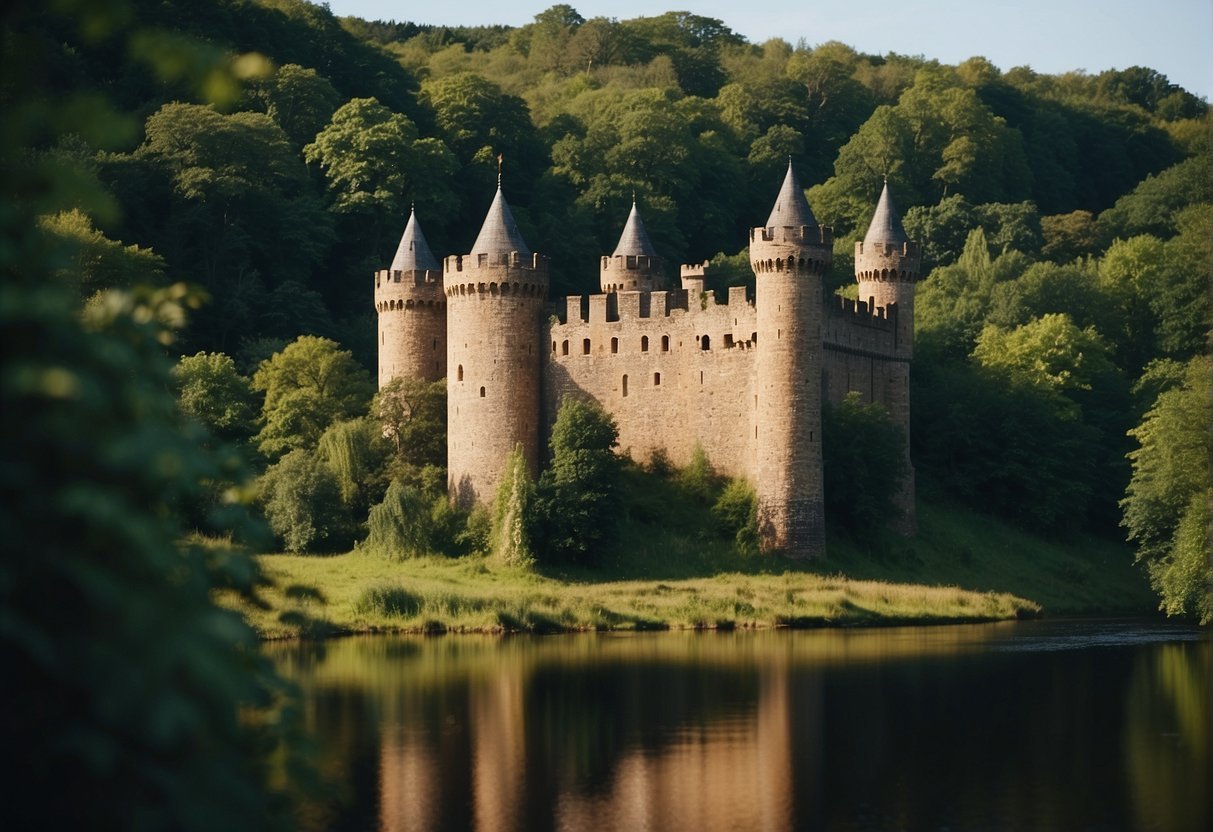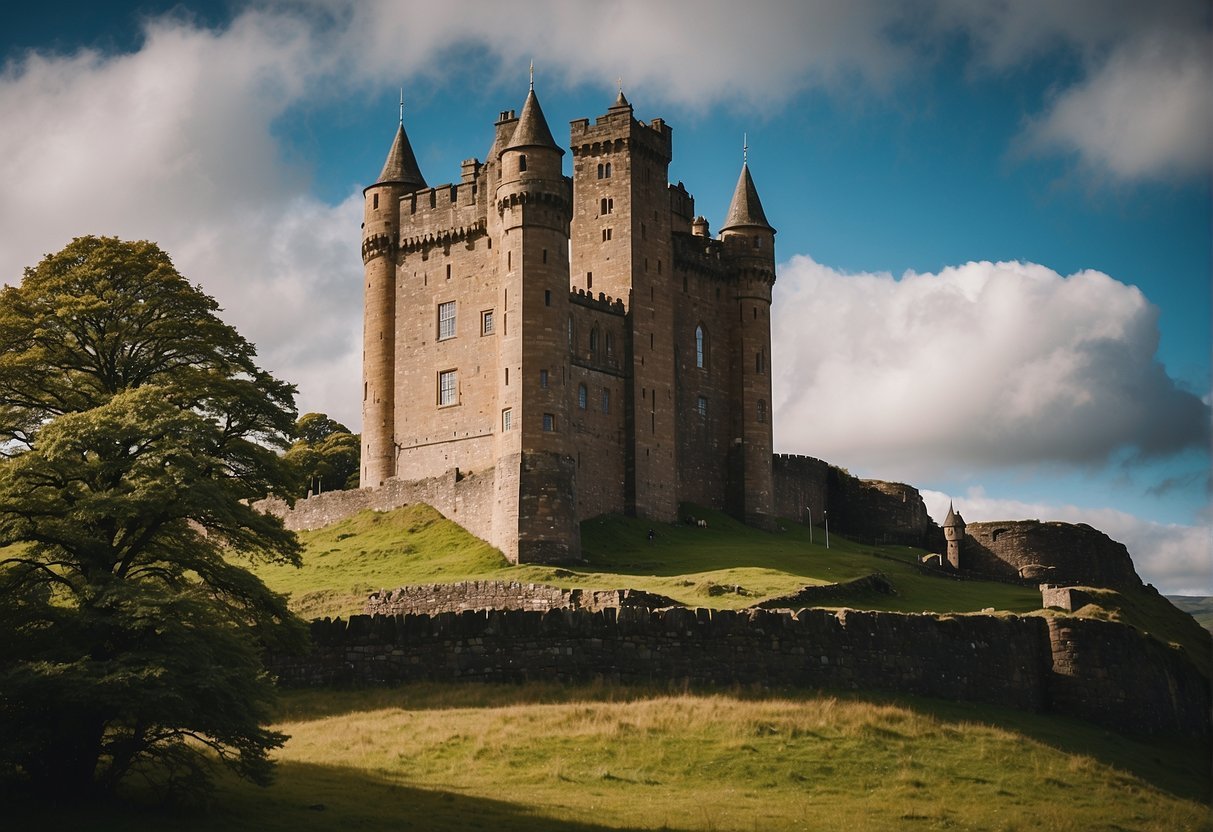Castles Near Glasgow – A Guide to Scotland’s Historic Strongholds
Stepping into the past and exploring the grandeur of castles that dot the picturesque landscape near Glasgow can be as enchanting as the tales told within their ancient walls.
Scotland is synonymous with this kind of historic charm, and the area around Glasgow is a treasure trove of medieval castles, each telling a story of the nation’s vibrant history and culture. Glasgow, thriving with culture and modern vibrancy, is the perfect starting point for these excursions into Scotland’s noble past.

As you journey through Scotland’s rolling hills and serene lochs, castles such as Bothwell and Dumbarton are sentinels to Glasgow’s storied history, inviting visitors to discover their hidden tales of battle, beauty, and nation’s birth.
Each castle presents unique architectural marvels, from towering turrets to haunting dungeons, offering a multidimensional view of Scotland’s architectural evolution. Not only are these structures steeped in history, but many cater to the public with tours and events, making them very accessible for anyone looking to delve into Scotland’s rich past.
Castles Near Glasgow – Key Takeaways
- Glasgow’s nearby castles offer a profound glimpse into Scotland’s history and cultural heritage.
- The architectural features of these castles highlight Scotland’s medieval craftsmanship and innovation.
- Many castles near Glasgow provide tours and events, enhancing their accessibility and educational value.
Historical Significance of Castles Near Glasgow

From their towering battlements to deep moats, you can almost hear the echoes of ancient battles and royal proclamations reverberating through Glasgow’s castles. These stone sentinels are picturesque ruins and the enduring legacy of Scotland’s tumultuous past and its journey to nationhood.
Strategic Importance and Wars of Independence
Bothwell Castle and Dumbarton Castle were formidable bulwarks during the Scottish Wars of Independence. Bothwell Castle’s strategic position on the River Clyde was a sought-after prize due to its potential to control central Scotland. It played a significant role in conflicts such as the War of Scottish Independence. Its imposing red sandstone keep is a testament to medieval military architecture.
Dumbarton Castle, perched atop Dumbarton Rock, has a human settlement dating back to the Iron Age. Due to its virtually impregnable location, it served as a royal refuge and a military stronghold, especially under figures like Robert the Bruce during the fight for Scottish freedom from English rule.
Residences of Royalty and Noble Figures
Crookston Castle and Stirling Castle were among the residences of Scottish kings and queens, and they often entertained noble figures within their walls. Stirling Castle, a symbol of Scottish independence and power, was the favoured residence of many Scottish kings and queens, including James V and Mary Queen of Scots.
Newark Castle and Balloch Castle showcase the lifestyle of Scotland’s aristocracy. Newark Castle on the shores of the Firth of Clyde was a Renaissance-period mansion that was comfortable and stylish, reflecting the increased desire for luxury living among the nobility. Balloch Castle in Dumbartonshire, though a 19th-century country house, captures the essence of the prestige associated with past castles and the changing tastes of Scotland’s elite over the centuries.
In these majestic structures, you can trace the line of Scotland’s history from the medieval era to the present day. Managed by Historic Scotland, they continue to be a source of national pride and a link to a time when the fate of nations was decided within their walls.
Architectural Marvels and Castle Features
When it comes to castle exploration, the devil is in the details—from imposing architectural feats to the intricacies of defensive designs.
Design and Defense Mechanisms
Castles near Glasgow showcase a diverse range of architectural styles and defence mechanisms. Standing as a formidable artillery fortification, Blackness Castle is designed uniquely in the shape of a ship. Its thick walls and daring caponier — a covered passage within a fortification — exemplify defensive innovation.
Similarly, the robust donjon, or central tower, symbolizes military might and architectural grandeur that has withstood the test of time. Tower houses, a common feature of Scottish castles, blend the comforts of a noble residence with the practical needs of a fortress.
- Great Hall: Central to castle life, where feasts and important meetings occurred.
- Artillery Fortifications: Like Blackness Castle, these are designed to withstand sieges.
- Caponiers: Provided protected shooting positions, often found in more enormous fortresses.
Castle Grounds and Accompanying Structures
The surroundings of a castle are as telling as the structure itself. The expansive courtyard was practical in assembling troops and a recreational space for the inhabitants.
For example, Craigend Castle is encapsulated in history with its Tudor Gothic style amidst the serenity of Mugdock Country Park. Beyond the immediate castle structures, you might find an ornate chapel or, in more eclectic estates, even a Chinese garden, adding a touch of whimsicality to the castle grounds.
- Renaissance Mansion: Sprawling estates reflecting the luxury and aesthetics of the era.
- Museum: Many castles, now historic sites, house museums with treasured artefacts.
- Royal Palace: Once the epicentre of power and splendour, like the grand halls at Stirling.
Embark on a tour of these majestic castles near Glasgow, where each stone and turret tells a story of warfare, luxury, and time-honoured architectural feats.
Accessible Tours and Events
“As you roam through Glasgow seeking adventures of yore, accessible tours and events near medieval castles await your discovery.”
Public Access and Opening Times
Many of the historic castles near Glasgow offer tours and have specific opening times for public access. Kelburn Castle, with its storybook facade and vibrant street art, invites visitors daily during summer from 10 am to 6 pm.
You can reach Kelburn easily for your day trip by taking a bus or train to Largs and then enjoy a taxi ride to the castle. Dean Castle in Kilmarnock, set amidst the scenic Dean Castle Country Park, opens its gates to history buffs from Thursday to Monday, between 11 am and 3 pm.
Here’s a quick guide:
- Kelburn Castle: Daily 10 am – 6 pm (Summer)
- Dean Castle: Thu – Mon 11 am – 3 pm
For those enchanted by the tales of kings and knights, Mugdock Country Park houses the remains of a medieval castle that witnessed centuries of history. With various park areas open all year round, it’s a perfect spot for families and individuals to enjoy the great outdoors and a slice of Scottish history.
Cultural Events and Filming Locations
The majestic strongholds near Glasgow don’t just stand still in time; they come alive with cultural events. For instance, Dunure Castle, perched dramatically on Castle Hill by the sea, often serves as an awe-inspiring backdrop for events and has been featured in renowned television series, notably in the popularity of the ‘Game of Thrones.’
Meanwhile, Balloch Castle Country Park stages a bounty of events throughout the year within its picturesque domains. Moreover, for those interested in the intersection of history and hospitality, Sherbrooke Castle Hotel provides a luxurious venue for various events, knit closely with the lore of Glasgow’s prestigious past.
Note the following:
- Dunure Castle: A scenic spot featured in film and television
- Balloch Castle Country Park: Host to diverse year-round events
- Sherbrooke Castle Hotel: Offers event spaces with a historical twist
Whether you are looking to explore on your own or are interested in scheduled tours, these historic locations near Glasgow provide rich experiences that are accessible and infused with the grandeur of Scotland’s heritage.
Notable Castles and Their Historical Context
Before venturing through the storied landscapes near Glasgow, you should familiarize yourself with the rich history that shaped these majestic stone guardians. Each stands as a testament to centuries of Scottish power struggles, advancements in fortification, and cultural evolution.
Bothwell Castle: The Power and Politics
Bothwell Castle—a symbol of medieval might and noble ambition—sits proudly on the banks of the River Clyde. Its construction commenced in the 13th century by the Clan Murray, manifesting the feudal power and political games of Middle Ages Scotland.
The castle has seen numerous conflicts, including the Wars of Scottish Independence, wherein leaders like William Wallace fought fiercely against English rule. Its ownership passed through several hands, but one notable figure, James Hamilton of Finnart, played a crucial role in extensive renovations during the Renaissance.
Dumbarton Castle: The Fortress on the Clyde
Perched on a volcanic rock, Dumbarton Castle has served as a military stronghold since the Dark Ages. With its strategic position at the narrowest part of the River Clyde, this fortress has witnessed vital historical figures such as Mary, Queen of Scots, who stayed here as a child before her brief voyage to France.
Over the centuries, it has been attacked, besieged, and rebuilt, bearing stories of Sir Patrick, Sir Walter Scott, and kings like James IV. Although not the inspiration for Game of Thrones, the iconic ruins echo the same aura of a drama-filled past, ripe with tales of sieges and royal escapades.






